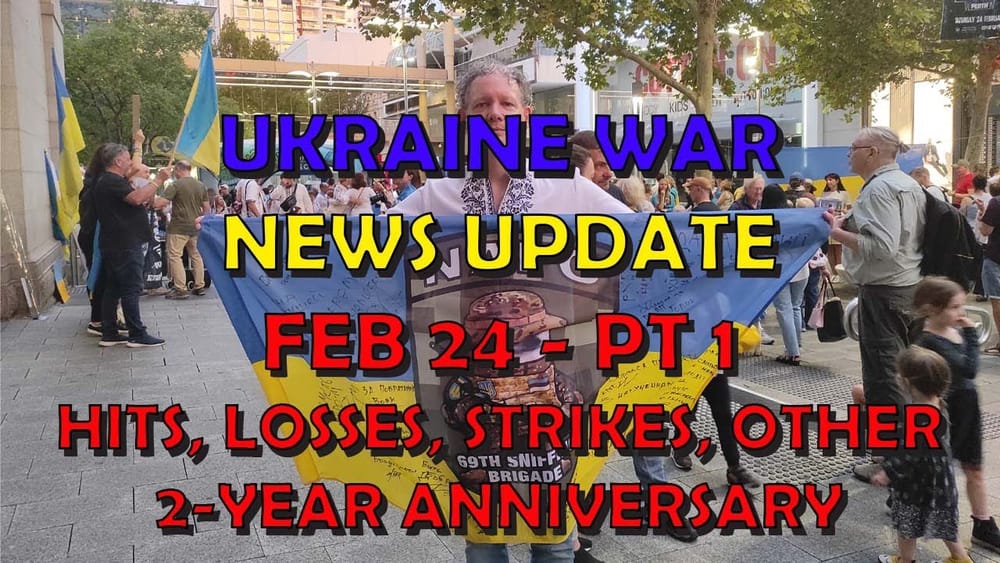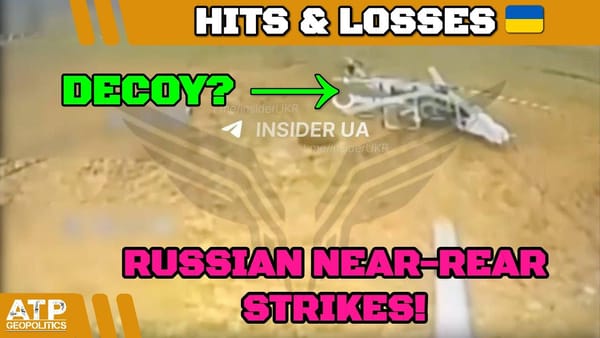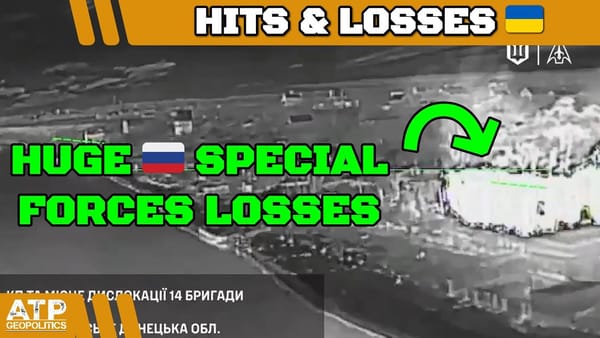Ukraine War Update NEWS: Pt 1 - Overnight & Other News, In Memoriam
Table of Contents 📖
"This is what freedom looks like in Russia. Freedom of speech here. Oh, yeah. Journalists get arrested for reporting on the wives of mobilized soldiers rallying.”
Hello Team
🎦 00:00-00:58⏩
Jonathan Pearce welcomes viewers to the two-year anniversary of the war, reflecting on the conflict. He's dressed for the occasion with a Ukrainian flag, a t-shirt from a "country of peace," and his "Russian Warship, Go F Yourself" mug. He reviews the daily Ukrainian General Staff report on Russian losses from the day before, reminding viewers that the figures are estimates.
Return to top⤴️
🪦 DISCLAIMER FOR GENERAL STAFF LOSSES DATA
- These are real people with real lives and real families who love them. Don’t let the numbers sap your humanity.
- These numbers probably aren’t accurate but they’re the best we have and we don’t need them to be accurate to be indicative of patterns of activity.
- All losses are estimates. Losses cannot be counted with accuracy because of the conditions on the ground.
- Both sides would see it to be of their advantage to minimize their own losses maximize the other side’s losses.
- Neither side releases their losses but we have enough transparency from the Ukrainian side to have confidence in they are indicative.
- Personnel losses are hard to count. If a soldier gets injured, heals up, and returns to the front line only to get injured again, is that one loss or two? Also, how to deal with losses from PMC’s or soldiers fighting with RF from occupied territories?
- Equipment losses are hard to count. If an AA complex involves several parts and one part gets disabled, is that a loss, or a fraction of a loss? If a tank gets disabled, repaired, back into the fight, then disabled again, is that one lost tank or two?
- All recorded losses are vulnerable to multiple reporting. We have already seen numerous cases of multiple drones in the air reporting the same loss from different angles as multiple engagements.
- Losses are not always reported on the same day they occurred. It is frequent that drone losses are reported at least 24 hours after other terrestrial equipment losses. Certain losses may not be reported for days or weeks for military intelligence reasons.
Russian Losses
🎦 00:58-06:31⏩
- Russian personnel losses: 770 (expected to decrease due to Avdiivka's capture, but still significant).
- Equipment losses: Eight tanks (up from the previous day); 15 armoured personnel vehicles (APVs, down from previous reports); 36 artillery systems (still considered substantial); two anti-aircraft warfare systems; one aircraft.
- Jonathan notes a trend of daily Russian aircraft losses.
- Analysis of visually confirmed losses from Andrew Perpetua's list, indicating a ratio of Ukrainian to Russian equipment losses at approximately 2:1. Jonathan points out that Ukraine would prefer a higher ratio.
- Detailed examination of Ukrainian equipment losses using Andrew Perpetua's list, including radar equipment, a T-64BV tank, Bradley infantry fighting vehicles (IFVs), and more. Jonathan expresses concern over the loss of a Bradley IFV.
- Discussion of the terminology used for IFVs, APCs (armoured personnel carriers), and AFVs (armoured fighting vehicles), questioning their distinct meanings.
- Extensive review of Russian equipment losses, highlighting the downing of an A-50 AWACS aircraft (confirmed by wreckage and crew remains). Jonathan emphasizes the significance of this loss, valued at $330-350 million, surpassing Ukrainian losses.
- Significant Russian losses also include numerous BMP infantry fighting vehicles (around 20-30) and approximately 15 APCs.
Downing of Russian Aircraft
🎦 06:31-19:47⏩
- In addition to the confirmed A-50 downing (covered in the previous topic), there were reports of other Russian aircraft losses.
- Jonathan clarifies an earlier report of a possible Il-22 downing in the Mariupol area, stating it was unfounded.
- Reports suggest two Su-34 jets may have crashed or been shot down near Henichesk in Kherson Oblast. Jonathan acknowledges visual evidence of one Su-34 explosion, leaving the second unconfirmed.
- Discussion on what weapon system downed the A-50, with many claiming the Patriot air defence system's range is insufficient.
- Counterarguments suggest modifications to Patriot missiles could extend their range beyond 200 kilometres.
- An alternative theory posits the use of a modified Ukrainian S-200 missile system, typically used for ground attacks but potentially modified for longer range air defence, citing Ukrainian media reports.
- Jonathan explores the concept of "Franken-SAM," where Ukrainian forces combine various air defence systems, potentially linking different radars for comprehensive coverage and selecting the optimal missile system for engagement.
- Analysis of a video showing a missile launch towards an aircraft (presumably the A-50), with some suggesting it was friendly fire from a Russian air defence system.
- Debate on the video's interpretation, with Jonathan acknowledging the possibility of the A-50 deploying flares in response to being locked on by a hostile radar system, potentially Russian.
- Further discussion on whether Russian air defences would intentionally target a Ukrainian air defence missile to protect the A-50, highlighting the lack of other defensive measures on the aircraft besides flares.
- Jonathan concludes that the truth behind the A-50's downing remains uncertain but emphasizes the significance of the loss for Russia, impacting their capabilities and morale. He predicts that the crew will be difficult to replace, and a new A-50 unlikely to be readily available.
- The loss will likely force the Russian Aerospace Forces (VKS) to limit their activities in the region.
Ukrainian Losses: Malakit Radar System
🎦 19:47-22:09⏩
- Shift in focus to Ukrainian losses, specifically the destruction of a VHF radar system called Malakit by a Russian Kh-35 (or X-35) anti-ship cruise missile.
- Jonathan finds the use of a cruise missile against a single land-based target unusual and speculates on the reasons, questioning if it highlights the system's importance, a lack of alternative munitions, or another factor.
- Despite being an older system (dating back to the 1970s), the Malakit, based on the P-18 radar, is assessed to be a valuable asset. Jonathan notes its ability to track fast-moving targets, process multiple targets simultaneously, and detect aircraft at considerable distances.
Overnight Drone and Missile Attacks
🎦 22:09-25:06⏩
- Recap of overnight drone and missile attacks. Ukraine reports intercepting all 12 Russian attack drones (Shaheds), achieving a 100% interception rate.
- Two out of three Russian Kh-59 missiles were also shot down. However, two Iskander-M ballistic missiles evaded air defences.
- Odessa was targeted again, with one downed drone striking an apartment building, resulting in casualties.
- On the Ukrainian side, there were reports of a successful attack on targets in Kerch, Crimea, although the specific targets are unknown.
- A large explosion occurred at a significant metalwork plant in Lipetsk, Russia, believed to be involved in weapons production.
- While Russia downplayed the incident, Ukrainian intelligence confirmed a drone attack on the plant.
- A fire also broke out at the Sukhoi aircraft manufacturer plant in Moscow, although Jonathan does not consider it a significant event, humorously suggesting it could be due to a careless smoker.
Polish Border Incident & Russian Propaganda
🎦 25:06-28:26⏩
- Jonathan reports on the third instance of Ukrainian agricultural products being spilled on a Polish railway station (Dorohusk), describing it as wasteful and frustrating.
- He expresses concern over videos of Polish protests at the border, where air raid sirens were sounded, questioning the motivations behind these demonstrations and their potential ties to Russian influence. He deems them unhelpful to Ukraine's efforts.
- Jonathan highlights Russian propagandist Vladimir Soloviev's threatening rhetoric towards Poland, citing Soloviev's statements advocating for the destruction of Polish cities with missile and airstrikes if they get involved in the conflict, drawing parallels to the US invasion of Iraq.
- He emphasizes the stark contrast between this aggressive rhetoric, sanctioned by the Russian government, and the type of discourse permitted on UK television.
- Jonathan finds it concerning that Soloviev's comments coincide with Polish protests, underscoring the potential for Russian propaganda to influence and exploit such situations.
Conditions for Russian Soldiers
🎦 28:26-32:23⏩
- Transitioning from the Polish border incident, Jonathan addresses a report from ChrisO_wiki on Twitter regarding the dire conditions faced by Russian soldiers on the front lines.
- The report highlights an increase in extrajudicial punishments within the Russian army, citing accounts of hangings, torture, and sexual abuse as means of maintaining discipline and coercing soldiers into participating in "meat assaults."
- Jonathan connects these reports to the psychological manipulation employed by the Russian military, where soldiers are presented with a "no-win" scenario. They are told surrendering will lead to execution by Ukrainians, forced into dangerous assaults, and threatened with punishment if they retreat. This creates a situation where attacking, even with a high chance of death, seems like the best option, perpetuating the cycle of meat assaults.
- Jonathan concludes that while the reports from ChrisO_wiki may not represent the situation across the entire front line, they are widespread enough to significantly impact morale within the Russian army.
Protests in Moscow and the Anniversary of the Invasion
🎦 32:23-36:03⏩
- Jonathan shifts to a report of journalists being arrested in Moscow while covering a rally organized by the wives of mobilized Russian soldiers. He criticizes this suppression of free speech, highlighting the risks faced by those who dare to question the war.
- Connecting this event to the previous topic, he suggests that as information about the horrific conditions and treatment of soldiers filters back to their families, protests like the one in Moscow will likely become more frequent and vocal, posing a significant challenge to the Kremlin's narrative and potentially impacting public support for the war.
- Jonathan reminds viewers that it is the second anniversary of the full-scale Russian invasion of Ukraine and the tenth anniversary of the broader conflict.
- He pauses to remember the Ukrainian lives lost, both soldiers and civilians, calling for a moment of reflection and respect for those who have sacrificed so much.
Messages of Hope and Ukrainian Resilience
🎦 36:03-39:52⏩
- Shifting to a more hopeful tone, Jonathan shares a Ukrainian folk song, "Oh, the Red Viburnum in the Meadow," performed first by a Ukrainian soldier and then by a larger group.
- The song, popular during times of struggle and resistance, serves as a reminder of Ukrainian resilience and their determination to overcome adversity. Jonathan describes the performances as both "impressive" and "beautiful" in their own way.
- He encourages viewers to attend pro-Ukraine rallies and gatherings if possible, sharing an anecdote about Matt Bishop, an Australian viewer, who sent pictures of himself at a rally in Perth. Jonathan thanks Matt for his support and encourages others to participate in similar demonstrations of solidarity.
Wrap Up
🎦 39:52-40:19⏩
- Jonathan concludes the video with a call to action, urging viewers to stay informed, engage in conversations about the war, and combat misinformation. He reiterates that part of his mission is to counter disinformation and present viewers with accurate information.
- He expresses gratitude to viewers like Matt Bishop for their continued support and engagement, emphasizing the importance of collective action in raising awareness.
- He ends with a final "Slava Ukraini" (Glory to Ukraine).



